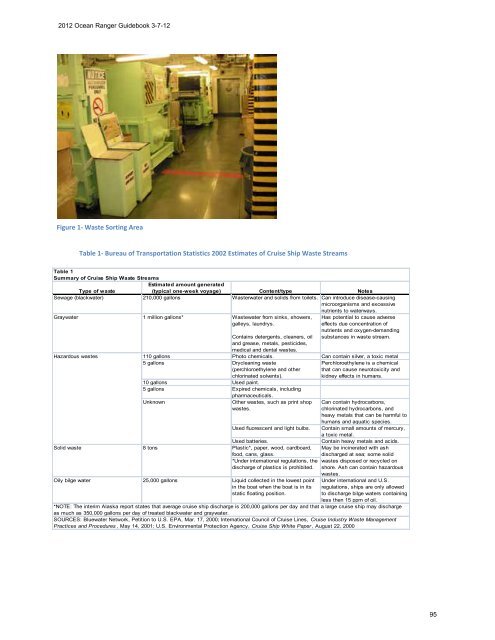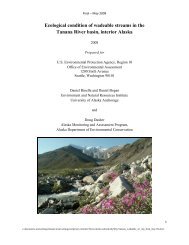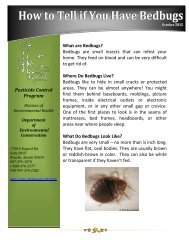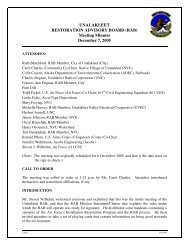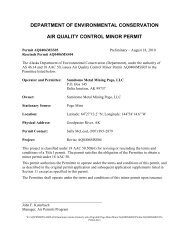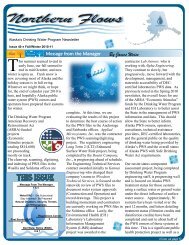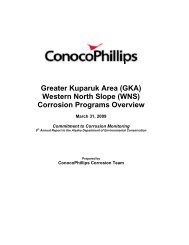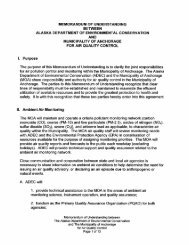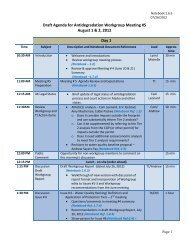2012 Ocean Ranger Guidebook Revision 3-7-12 - Alaska ...
2012 Ocean Ranger Guidebook Revision 3-7-12 - Alaska ...
2012 Ocean Ranger Guidebook Revision 3-7-12 - Alaska ...
Create successful ePaper yourself
Turn your PDF publications into a flip-book with our unique Google optimized e-Paper software.
<strong>20<strong>12</strong></strong> <strong>Ocean</strong> <strong>Ranger</strong> <strong>Guidebook</strong> 3-7-<strong>12</strong><br />
Figure 1- Waste Sorting Area<br />
Table 1<br />
Summary of Cruise Ship Waste Streams<br />
Estimated amount generated<br />
Type of waste<br />
(typical one-week voyage) Content/type Notes<br />
Sewage (blackwater) 210,000 gallons Wasterwater and solids from toilets. Can introduce disease-causing<br />
microorganisms and excessive<br />
nutrients to waterways.<br />
Graywater 1 million gallons* Wastewater from sinks, showers,<br />
galleys, laundrys.<br />
Hazardous wastes<br />
Solid waste<br />
Table 1- Bureau of Transportation Statistics 2002 Estimates of Cruise Ship Waste Streams<br />
Contains detergents, cleaners, oil<br />
and grease, metals, pesticides,<br />
medical and dental wastes.<br />
Has potential to cause adverse<br />
effects due concentration of<br />
nutrients and oxygen-demanding<br />
substances in waste stream.<br />
110 gallons Photo chemicals. Can contain silver, a toxic metal<br />
5 gallons Drycleaning waste<br />
(perchloroethylene and other<br />
chlorinated solvents).<br />
10 gallons Used paint.<br />
5 gallons Expired chemicals, including<br />
pharmaceuticals.<br />
Unknown<br />
Other wastes, such as print shop<br />
wastes.<br />
8 tons<br />
Perchloroethylene is a chemical<br />
that can cause neurotoxicity and<br />
kidney effects in humans.<br />
Can contain hydrocarbons,<br />
chlorinated hydrocarbons, and<br />
heavy metals that can be harmful to<br />
humans and aquatic species.<br />
Used fluorescent and light bulbs. Contain small amounts of mercury,<br />
a toxic metal.<br />
Used batteries. Contain heavy metals and acids.<br />
Plastic*, paper, wood, cardboard,<br />
food, cans, glass.<br />
*Under international regulations, the<br />
discharge of plastics is prohibited.<br />
Oily bilge water 25,000 gallons Liquid collected in the lowest point<br />
in the boat when the boat is in its<br />
static floating position.<br />
May be incinerated with ash<br />
discharged at sea; some solid<br />
wastes disposed or recycled on<br />
shore. Ash can contain hazardous<br />
wastes.<br />
Under international and U.S.<br />
regulations, ships are only allowed<br />
to discharge bilge waters containing<br />
less then 15 ppm of oil.<br />
*NOTE: The interim <strong>Alaska</strong> report states that average cruise ship discharge is 200,000 gallons per day and that a large cruise ship may discharge<br />
as much as 350,000 gallons per day of treated blackwater and graywater.<br />
SOURCES: Bluewater Network, Petition to U.S. EPA, Mar. 17, 2000; International Council of Cruise Lines, Cruise Industry Waste Management<br />
Practices and Procedures , May 14, 2001; U.S. Environmental Protection Agency, Cruise Ship White Paper , August 22, 2000<br />
95


